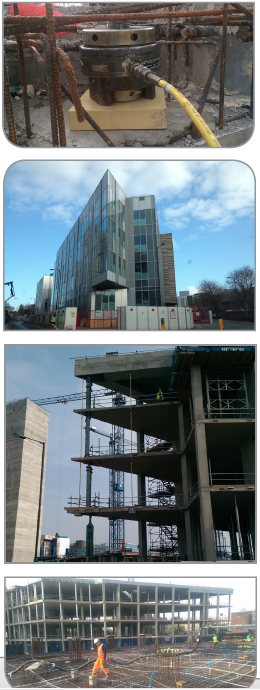 Architect
Architect
Fairhurst Design Group
Structural Engineer
AECOM
Main Contractor
Shepherd Construction
Frame Contractor
Heyrod Construction
Post-tensioning
Freyssinet Limited
Works Completed
September 2014
The Ronald Ross Bio-Science Building, known as Apex during construction, is a four storey research facility for the Faculty of Medicine at the University of Liverpool. It incorporates specialist, highly serviced, controlled laboratory environments to containment on level two and three. The facility accommodates 600 researchers who support the University’s health research into infectious diseases, cancer and digestive diseases. The £90m development was funded by the University of Liverpool and the Higher Education Funding Council for England.
The building design has achieved BREEAM ‘excellent’ status and incorporates many energy saving measures to ensure the facility contributes to the carbon reduction commitment made by the university.
The development has been constructed in two phases and Freyssinet was involved in the larger (11,170m2) phase 2. The building sits opposite the new Royal Liverpool University Hospital, which was also constructed by a Heyrod-Freyssinet team.
The floor plate of phase two measured 100 by 37m and the length was split in two by a permanent movement joint. In the laboratory areas the slabs were 400mm thick for a grid of 9.9 by 6.6m. The office areas have 250mm thick slabs for 6.0 by 5.7m column spacing. The design loading in both the laboratory and office areas is 5.0kN/m2 live and 3.3kN/m2 superimposed dead.
The building is located at the junction of Crown Street and West Derby Street, where an acute angle on the site gives Apex its name and the building its principal feature. However, the architectural design dictated that the point of the apex could not be supported by a column coming down to ground level, so three storeys of structure had to be hung from the fourth floor roof where two 1200mm wide by 1200mm deep post-tensioned beams cantilevered 10.4m.
The floors below are supported by three 51mm diameter Freyssibars from these roof-top beams. The high tensile bars used were the ‘Freyssibar + HSA’, which are high performance prestressing bars which have been specially heat treated (quench and tempered) to ensure increased mechanical characteristics.
The resulting ductility, tensile and yield strengths are greater than for typical prestressing bars (HSA bars may be bent 90 degrees at tight radii without fracture) as follows:
• Minimum Guaranteed Ultimate Tensile Strength: fpk = 1,070 MPa
• Minimum Yield Strength: fp0.2k = 870 MPa
• Minimum Elongation at Break (on sample): A = 12%
